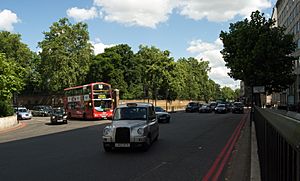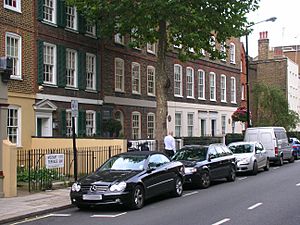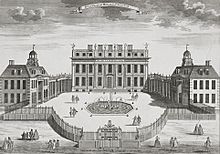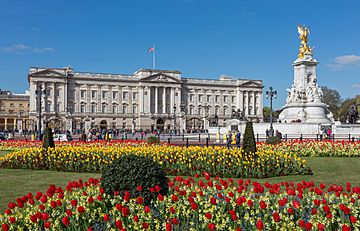Eia facts for kids

Eia or Eye was a large estate, called a manor, during the early Middle Ages. It was located in the area of Westminster, Middlesex, which is now part of Central London. The manor was about one mile west of the Palace of Westminster and about half a mile north of the River Thames.
Today, the land that was once the Eia manor includes many famous places. These include much of Hyde Park, the grounds of Buckingham Palace, and areas like Belgravia, Park Lane, Mayfair, Pimlico, and Knightsbridge.
Contents
What's in a Name?

The name Eia probably comes from an old Anglo-Saxon word, īeg. This word means "island." It might have been used because the area was a raised piece of land near a stream or marsh. This could refer to Thorney Island, where Westminster Abbey is built.
A smaller part of the Eia manor was called Ebury or Eybury. This area included a small village called Eye Cross. The names Ebury and Avery (a slightly changed version) are still used today in modern place names.
Ebury in Modern Names
You can still find the name Ebury in places like Ebury Street in Belgravia, Ebury Square, Ebury Wharf, and Ebury Bridge. The name Avery is also used in many street names in the area.
A noble title, Baron Ebury, was created in 1857 for Robert Grosvenor. His family owned much of this land. Some street names in the former Ebury manor, like Eaton, Belgrave, and Eccleston, come from his family's estates in Cheshire. There was even a railway line called the "Ebury Line," which is now a hiking trail called the Ebury Way.
Eia in the Middle Ages
During the early medieval period, Eia was a countryside estate. It was next to the River Tyburn, which now flows under Buckingham Palace. It was also near Thorney Island, where Westminster Abbey was built.
The ownership of Eia changed many times over the years. Important people like Edward the Confessor and his queen, Edith of Wessex, owned it in Saxon times. After the Norman Conquest, William the Conqueror gave the land to Geoffrey de Mandeville. He then gave it to the monks of Westminster Abbey.
Around the time of the Domesday Book in 1086, the large Eia manor was split into three smaller manors:
- Hyde (the north-western part)
- Ebury (the central area)
- La Neyte or Neat (to the south-east)
Neyte was a small island in the marshy area that is now Pimlico. A house was built there for the Abbot of Westminster.
Early Modern Times

In 1531, King Henry VIII took over the Hospital of St James (which later became St. James's Palace). Then, in 1536, during the Dissolution of the Monasteries, the Manor of Ebury became part of the Crown's (the King's) possessions again. This meant the land where Buckingham Palace now stands returned to royal ownership, nearly 500 years after it had been given away.
By the early 1600s, the lease for the manor had been passed to many different people. The old village of Eye Cross no longer existed, and most of the area was empty land. During the time of King James I (1603-1625), some of the land was sold. King James also created a large mulberry garden on part of the land, near where Buckingham Palace is today.
How the Area Grew

In the late 1600s, the ownership of Ebury passed to Mary Davies. She and her relative, Sir Hugh Audley, were very important in turning Ebury Manor into a developed area. This area now includes Mayfair, Belgravia, and Park Lane. Streets like North Audley Street, South Audley Street, and Davies Street in Mayfair are named after them. Much of Mary's inherited land is now part of the Grosvenor Estate.
Buckingham House, which is the main part of Buckingham Palace today, was built in 1703. It was designed by William Winde for John Sheffield, 1st Duke of Buckingham and Normanby. In 1761, the house was sold to King George III, bringing it back into the royal family's ownership.

